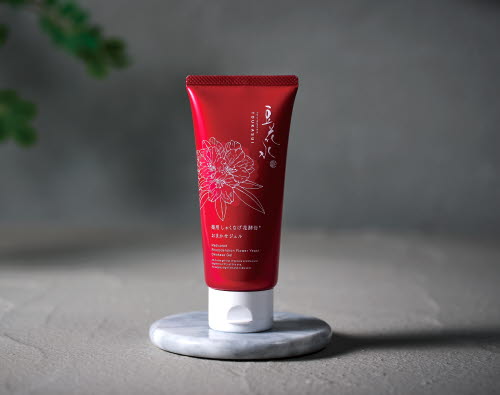The cosmetics division of JIMOS Co., Ltd. has an unusual background in the field, says Yuichi Yoshimaru of the company’s Natural Materials Division. It’s hinted at in the company’s Tofu no Moritaya brand name. “The company was originally located in Miyazaki Prefecture on Kyushu Island and was a tofu manufacturer in Shiiba, a village surrounded by forests,” Mr Yoshimaru explains. “A woman working at one of the tofu factories had very rough hands since she had worked in forestry for many years. However, once she started working with tofu, her hands became almost unbelievably smooth. That was because she washed her utensils in water that was mostly tonyu, or soy milk every day.” The company then began manufacturing soy-milk-based cosmetics, thinking that the material had ingredients that would help beautify the skin.
Now based in Fukuoka City, the largest metropolitan area in Kyushu, JIMOS and Mr Yoshimaru are working on a product called Toukasui Rhododendron Flower Yeast Omakase Gel, a family of skin care products combining tonyu with extracts of shakunage, a flower in the rhododendron family. “Toukasui” combines the characters of bean, flower and water. “It’s an all-in-one moisturising gel containing original soy milk ingredients and rhododendron yeast extract,” Mr Yoshimara explains. “It also contains the active ingredient niacinamide, a quasi-drug product that has been shown to be effective in preventing skin discolouration and fighting wrinkles.”

Many of the Tofu no Moritaya-branded products are not boxed but are instead sold shrink-wrapped in the container housing the liquid product. “My feeling, though, is that it’s better if a product like Toukasui Rhododendron Flower Yeast Omakase Gel arrives at the customer’s home in a box instead,” Mr Yoshimaru says. “It’s packaged in a shiny tube, so we wanted to put it in a box to protect it from scratches. It gives a much better impression.” The package is quite attractive, featuring a stylized drawing of a rhododendron flower in black lines overlaid with red and the product name in hand-written kanji or Chinese characters. “For our Tofu no Moritaya-brand products, we do use kanji, but also try to give it a slightly modern, Japanese feel.”
So, how did he begin the design process for this new flagship product? “Well, the package is really the face of the project, so I work from the beginning with the manufacturing committee and try to make everyone’s ideas a reality.”
Part of the process, too, was selecting the paperboard for the box itself. For this, Mr Yoshimaru turned to Holmen's Invercote. “The box has illustrations that go around the front and side of the box,” he says. “If I used a normal paper, the printing could break along the folds. Invercote, however, is quite dense, so it can stand up to the folding, so the printing holds up very well.” Interestingly, they are not using the coated surface of the Invercote paperboard for the box exterior but the matte side of the paperboard. “It has a slight roughness that I think matches the style of the design.”
He adds that, until last year he was not familiar with Holmen’s paperboard until a company representative visited JIMOS. “I thought it was a wonderful paperboard, so I’m using it in several other products as well, and I’d like to give more products attractive boxes as well.”


